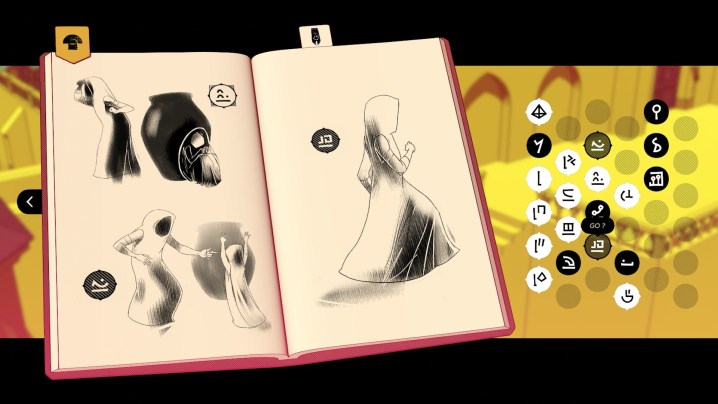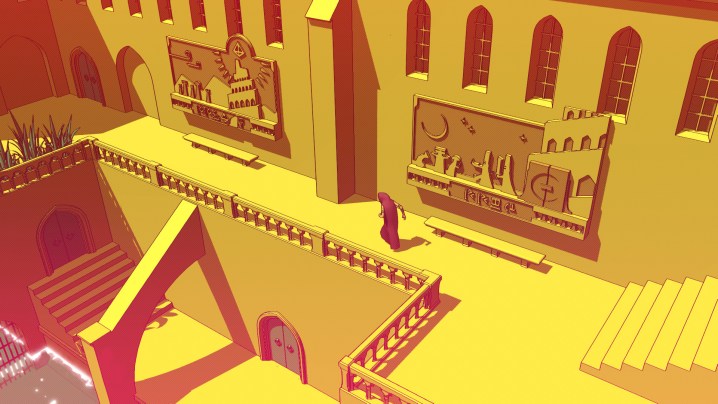“Chants of Sennaar is an ingenious linguistic puzzle game that takes the right notes from genre greats like Return of the Obra Dinn.”
- Ingenious logic puzzles
- Thoughtfully built languages
- Engrossing setting
- Striking art style
- Navigation can be tricky
When I was first dropped into Chants of Sennaar, I was a stranger in a strange land. Without a word of English to guide me, I was left wandering around a desert village perched on a tower, struggling to understand locals who only speak in foreign symbols.
No more than an hour later, I was a budding anthropologist. I’d decipher a set of murals that taught me the setting’s mythology, learn the class structure of the tower, and even get to a point where I could write my own sentences from a small handful of symbols. To reach that point, I’d need to stop seeing myself as an alien and start finding common ground with my fellow man. After all, the only thing that separates us in the multilingual tower is the symbol used to describe us.
Chants of Sennaar is an ingenious puzzle-adventure about the nuance and complexity of communication. Players aren’t just uncovering the meaning behind foreign letters, but learning how language can be used to celebrate what we value in our cultures … or oppress ones we don’t agree with.
Learning languages
Inspired by the myth of Babel, Chants of Sennaar is a unique 3D adventure that turns language into logic puzzles. In order to ascend a mysterious tower and learn its secrets, players need to decipher five distinct languages, putting words to mysterious symbols via in an in-game notebook. It’s a daunting task at first, but one that’s made easy thanks to a bevy of smart design decisions.
To make the process more manageable, Chants of Sennaar borrows from the best: Return of the Obra Dinn. Just like Lucas Pope’s critically adored deduction game, Chants of Sennaar has a validation system that lets players verify a set of symbols by placing them next to images in their journal. Even when I was stumped, I could use that to pick up some extra context clues and better understand what kinds of words and concepts are common throughout the tower.

That system is a helpful fail-safe, but I was impressed by how often I didn’t need to lean on it. That became clear immediately after being thrown into the game’s opening village, as I quickly became an expert on how its people speak. Some of the cues are clearly telegraphed. When a child invites me to play hide-and-seek, I begin to understand what symbols stand in for you, I, seek, and find. Other puzzles require some creative thinking. When I find a series of murals depicting the spiritual conflict that led to the tower’s power struggle, I need to make some educated guesses about what I’m seeing. I scribble words like “villager” and “God” over the symbols, piecing together some version of the truth. It’s an absorbing loop that has me racking my brain as I try to translate runes without using a word of my own tongue.
I’m not always right, but that’s part of the game. Sometimes I see my rough translations pop up in another context and realize I’m off, like an embarrassed tourist using the wrong words with a local. Those moments push me to not just learn individual words, but the ways in which a language actually functions. For instance, different people have different methods for pluralization and even basic sentence structure. To ascend, I need to become fluent in those grammatical nuances too.
It pushes me to understand why languages are constructed the way they are.
What’s even more engrossing is how much I learn about each of the game’s five factions through the handful of common words they use. When I infiltrate the ranks of the knights patrolling the tower, I begin to see oppressive words like “weapon” and “duty” pop up — as well as some loaded terms for the other inhabitants in the tower. I get the sense that they’re a disciplined group living by a firm code of rules. Later, I stumble on a town full of free-spirited artists, and their language is far more playful, with symbols representing art and music. Each language feels distinct, giving me a glimpse at the differing cultures populating the tower and their values.
Chants of Sennaar isn’t just a clever word game; it pushes me to understand why languages are constructed the way they are. The higher I climb, the more I seek to understand who holds the power in a multisided war, and how words can be carefully shaped into propaganda to win me over to one side.
Complex puzzles
While the bulk of Chants of Sennaar is built around deciphering words, it finds a surprising number of ways to twist that idea into more traditional puzzling. When I discover a culture of laborers and scientists, I’m suddenly transmuting metals and uncovering formulas using a language dependent on math and science. Any puzzle that looks hopeless at first glance usually has a clear solution hiding elsewhere in the world, even if it requires a little extra thought to find the solution. One town seems like an impossible labyrinth until I find the words I need to orient myself.
I’m entranced by the tower, with all of the bright colors and gorgeous sounds …
In a cleverly self-reflexive move, Chants of Sennaar is just as much about learning the language of video games as it is about human tongues. Even something as simple as stealthily moving around guards requires me to understand basic pattern recognition, as I time my movements to create audio distractions to “solve” a room. One late-game puzzle has me crafting a key using the same kind of mathematics problem-solving that I’d expect to see in a Professor Layton game. Just as Chants of Sennaar teaches me why languages are constructed the way they are, it does the same for puzzle game design.
Its only weaknesses come in the moments where it strays away from that core thesis. With no maps to orient me, a few sections had me backtracking between distant rooms as I looked for some clue I missed or logical leap that was the key to setting up the next puzzle. Those few frustrating moments become more about spatial awareness as I tediously bounced around mazes looking for the next puzzle piece (a handy button highlights all interactable objects in a room, and I recommend using it liberally).

But like mistranslating a word, getting lost isn’t always a bad thing. It gives me a chance to once again pass by villagers I previously couldn’t understand or murals I couldn’t read. Even decoding one word can help me understand a whole sentence, leading to more discoveries. Even when it doesn’t, the extra time spent strolling allows me to soak in Chants of Sennaar’s Moebius-inspired art style, which is full of pop art that makes it feel like a spiritual cousin to 2021’s Sable. I’m entranced by the tower, with all of the bright colors and gorgeous sounds that represent its diverse inhabitants.
When I set out on my adventure initially, I’m just a tourist eager to get from one place to the other without thinking about the spaces I’m moving through. The deeper I get, the more I realize the cultural significance of every place I visit. A simple card game early on takes on new meaning when I realize it’s subtly teaching me the class structure of the entire tower. The more I look and listen, actually engaging with what the people of the tower are trying to communicate, the more invested I am in their struggles. Though as eager as I am to help, I also need to learn that language is a powerful multitool that can be used to educate, mislead, or manipulate. That’s the true test I find in the tower; a moral meta-puzzle that can’t be solved with a simple translation.
Chants of Sennaar was tested on PC and Steam Deck.





